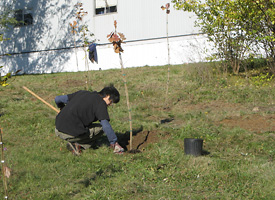Continued forestry efforts by staff and students have earned the U-M Ann Arbor campus recognition as a Tree Campus USA institution by the Arbor Day Foundation for the fourth consecutive year.
U-M is one of 115 colleges and universities out of more than 2,000 nationwide to achieve Tree Campus USA status in 2011.

A U-M student plants a tree during last fall’s planting event on North Campus. Photo courtesy of Grounds and Waste Management.
“Community involvement has been key to our success in receiving this recognition annually since 2008,” says Marvin Pettway, U-M grounds senior supervisor. “I am very pleased we have such an active and engaged community supportive of environmental stewardship on campus.”
The Tree Campus USA program was created through a partnership between the Arbor Day Foundation and Toyota Motor North America Inc. to award recognition to college campuses and community leaders “for promoting healthy urban forest management and engaging the campus community in environmental stewardship.”
In order to achieve Tree Campus USA status, universities must meet specific requirements, which include: effective management of campus trees; developing connectivity with the community beyond campus borders to foster healthy, urban forests; and engagement of students in campus and community forestry efforts.
Grounds and Waste Management staff collaborated with various departments, including the University Planner’s Office, the Office of Landscape Architecture and the Department of Occupational Safety and Environmental Health, to add 531 trees to campus last year. Students from the U-M Women’s Rowing team, Program in the Environment, and the engineering honor societies Chi Epsilon and Tau Beta Phi planted a hundred of the trees near the North Campus Chiller Plant and Naval Architecture.
In addition to maintaining a green landscape on campus, Grounds staff actively is pursuing other ways to make the campus more environmentally sustainable, including reducing the amount of de-icing salt used during the winter, composting and utilizing compost tea as a component in turf fertilization, and the conservation and improvement of the woodlots on campus.
“We’d like to continue to offer opportunities for staff and students to collaborate on efforts to create a beautiful and environmentally sustainable campus,” Pettway adds.

